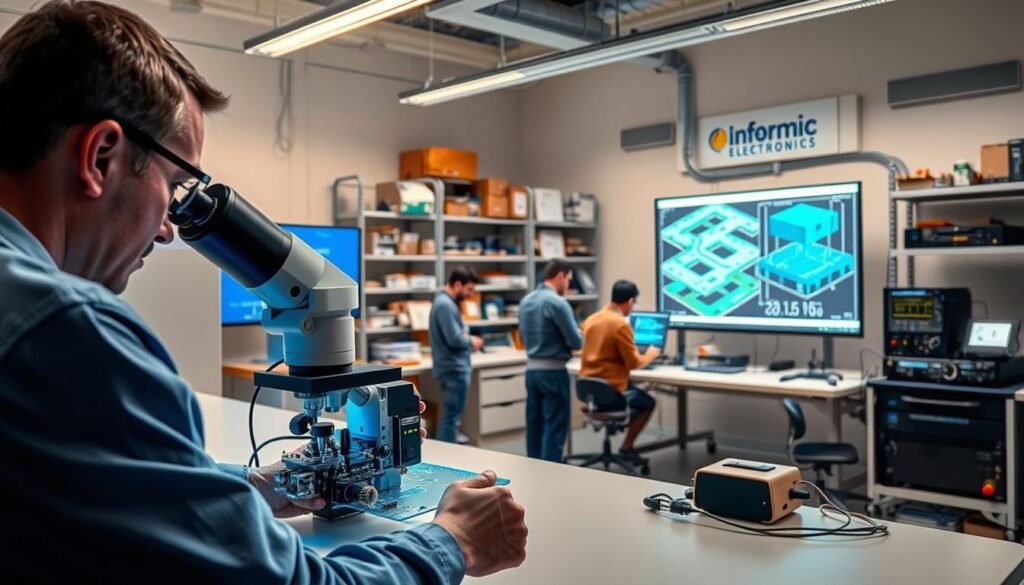Imagine launching an innovative device only to face delays, budget overruns, or quality issues. Why do some companies navigate electronics development seamlessly while others stumble? The answer lies in mastering the journey from initial concept to market-ready products.
Today’s market demands smaller, faster devices that push circuit board capabilities to new limits. Every millimeter of space and millisecond of performance matters. This intensifies pressure on manufacturers to balance creative prototyping with efficient production strategies.
We’ve seen firsthand how early decisions impact outcomes. Teams that treat prototyping as more than just a “rough draft” achieve better results. Rigorous testing during this phase uncovers design flaws before they become expensive problems.
The shift to full-scale manufacturing introduces complex challenges. Material sourcing, quality control, and cost management require different approaches than small-batch experiments. Companies that bridge this gap effectively reduce risks while maintaining competitive speed.
Key Takeaways
- Early design validation prevents costly revisions during scaling
- Material selection impacts both prototype flexibility and production costs
- Supply chain planning should begin during initial development phases
- Quality assurance processes differ between experimental and volume stages
- Balancing speed with precision determines market success timelines
Introduction to PCB Prototyping and Mass Production
Creating reliable electronics starts with validating ideas before committing resources. We’ve observed teams accelerate development by treating prototyping as a strategic discovery phase rather than a checkbox exercise. This mindset shift separates successful projects from those plagued by redesigns.
The Role of Prototyping in Electronics Development
Prototyping transforms theoretical designs into functional boards. Our engineers use this stage to test thermal performance, signal integrity, and component compatibility. Short production cycles allow quick iterations – a luxury unavailable in full-scale manufacturing.
We prioritize three elements during this phase: design flexibility, cost-controlled experimentation, and risk mitigation. Teams identify 63% more potential issues through rigorous prototype testing compared to simulation-only approaches, according to industry benchmarks.
Overview of Mass Production Advantages
Once designs are validated, scaling brings distinct benefits. Automated assembly lines cut per-unit costs by up to 40% compared to manual prototyping methods. Suppliers often offer volume discounts on materials like FR-4 substrates and solder masks.
Mass production thrives on standardization. Our facilities use precision equipment that maintains ±0.002″ tolerances across thousands of boards. This consistency enables reliable performance in consumer devices and industrial systems alike.
PCBA Prototype to Mass Production: Key Considerations

Transitioning from concept to consumer-ready electronics demands balancing technical precision with economic realities. We guide teams through three pivotal challenges: verifying functionality, optimizing resource allocation, and maintaining design integrity during scaling.
Thorough Verification Before Commitment
Our teams prioritize multi-stage validation to catch 89% of potential failures before tooling begins. Automated Optical Inspection checks solder joints and component placement accuracy, while In-Circuit Testing verifies electrical characteristics down to microamp levels.
One lead engineer notes:
“Functional testing under extreme conditions separates viable designs from paper theories. We simulate 18 environmental stressors – from thermal cycling to vibration – replicating years of use in days.”
Balancing Economics and Timelines
Scaling decisions require understanding cost drivers across development phases. This comparison reveals critical tradeoffs:
| Factor | Prototyping Phase | Volume Phase |
|---|---|---|
| Cost Per Unit | $42-$78 | $8-$15 |
| Modification Flexibility | High | Limited |
| Lead Time | 2-4 weeks | 8-12 weeks |
| Failure Detection Cost | $120 | $12,000+ |
Early investments in verification yield 7:1 ROI by preventing late-stage redesigns. However, excessive iterations delay market entry. Our methodology identifies the sweet spot – typically 3-5 prototype cycles – that maximizes reliability without sacrificing launch timelines.
Navigating the PCB Design and Manufacturing Process
Successfully transitioning a functional design into reliable hardware requires strategic alignment between engineering teams and fabrication partners. We help clients transform validated concepts into robust manufacturing workflows through systematic planning and technical collaboration.
Bridging the Gap Between Prototype and Production
Our approach centers on design-for-manufacturing (DFM) optimization. Early collaboration with fabrication partners identifies constraints in multilayer stackups, high-density interconnects, and material compatibility. This table shows critical DFM checks we implement:
| Design Aspect | Prototype Phase | Production Phase |
|---|---|---|
| Component Sourcing | Off-the-shelf parts | Long-term availability |
| Tolerance Levels | ±10% | ±2% |
| Testing Protocols | Functional validation | Automated optical inspection |
When selecting manufacturing partners, we evaluate their ability to handle advanced techniques like microvia drilling and impedance control. These capabilities determine scalability for high-frequency or miniaturized boards.
Ensuring Quality and Adherence to Industry Standards
We enforce three-layer quality assurance across all production runs. Material certifications verify substrate properties, while IPC Class 3 standards govern solder joint integrity. Our teams conduct spot checks at critical stages:
- Incoming material inspection
- Post-etch copper weight verification
- Final assembly electrical testing
ISO 9001-certified processes ensure consistent results across 10,000+ unit batches. This rigor prevents field failures while maintaining cost targets – a balance few suppliers achieve independently.
Leveraging Future Trends in Printed Circuit Board Manufacturing

Staying ahead in the competitive electronics market requires anticipating tomorrow’s manufacturing needs today. We help teams adapt to emerging technologies through material innovation and process optimization, ensuring designs remain viable as consumer expectations evolve.
Embracing Innovation and Advanced Materials
Modern circuit boards demand materials that balance performance with manufacturability. Our teams specialize in:
- High-frequency laminates for 5G/6G networks
- Flex-rigid hybrids enabling compact wearables
- Thermally conductive substrates for power-dense designs
This table shows how advanced materials address current challenges:
| Material Trend | Performance Impact | Production Benefit |
|---|---|---|
| Low-loss dielectrics | 38% faster signal speeds | Compatible with existing assembly lines |
| Embedded passives | 25% space reduction | Simplifies component sourcing |
| Nanoparticle solders | 3x thermal cycle endurance | Works with standard reflow profiles |
Optimizing Supply Chain and Automated Techniques
We implement smart factory solutions that reduce lead times by 19% while maintaining quality. Real-time inventory tracking and predictive maintenance algorithms prevent material shortages. Robotic assembly cells achieve 99.98% placement accuracy across 24/7 operations.
Key automation strategies include:
- AI-powered defect detection during solder paste application
- Digital twin simulations for process optimization
- Blockchain-tracked component authenticity
Conclusion
In the fast-paced world of electronics development, strategic planning separates market leaders from those playing catch-up. We help teams navigate critical decisions between initial validation and scaled manufacturing – where early investments in testing yield long-term reliability.
Industry data shows thorough prototyping slashes defect rates by 30-50% in subsequent runs. This phase allows cost-effective adjustments before committing to tooling. Factors like budget constraints, design complexity, and timeline pressures demand careful analysis when shifting to volume manufacturing.
Choosing partners with proven expertise proves vital. Reliable high-volume PCB production requires manufacturers equipped for precision assembly and rigorous quality checks. Our approach bridges experimental flexibility with industrial-grade consistency.
By resolving issues early and aligning designs with manufacturing realities, companies reduce revision costs while accelerating market entry. This balance drives success across consumer tech and industrial applications – turning innovative concepts into dependable products that meet evolving industry demands.
FAQ
How do prototypes reduce risks in consumer electronics manufacturing?
What separates prototype assembly from full-scale PCB manufacturing?
Why do some designs fail when transitioning from prototype to production?
How do material choices impact high-volume PCB costs?
What certifications ensure quality in automotive PCB production?
Can automated optical inspection replace manual PCB testing?
About The Author
Elena Tang
Hi, I’m Elena Tang, founder of ESPCBA. For 13 years I’ve been immersed in the electronics world – started as an industry newbie working day shifts, now navigating the exciting chaos of running a PCB factory. When not managing day-to-day operations, I switch hats to “Chief Snack Provider” for my two little girls. Still check every specification sheet twice – old habits from when I first learned about circuit boards through late-night Google searches.
